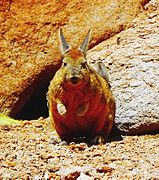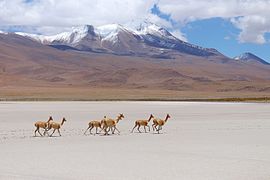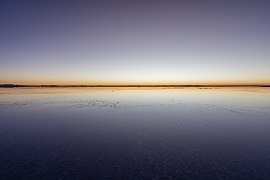Salar de Luminar: Difference between revisions
Mr.Trumpet (talk | contribs) |
Mr.Trumpet (talk | contribs) No edit summary |
||
| Line 32: | Line 32: | ||
==Legend== | ==Legend== | ||
The [[Tuachec]] have a myth to explain the creation of the Salt Flats of Luminar. In the ancient times, long before the arrival of explorers and settlers, the land that is now known as the Salar de Luminar was a fertile valley filled with lush vegetation and vibrant wildlife. The valley was home to the gods of the elements, who lived in harmony and provided balance to the natural world. | The [[Tuachec|Tuachec Empire]] have a myth to explain the creation of the Salt Flats of Luminar. In the ancient times, long before the arrival of explorers and settlers, the land that is now known as the Salar de Luminar was a fertile valley filled with lush vegetation and vibrant wildlife. The valley was home to the gods of the elements, who lived in harmony and provided balance to the natural world. | ||
Among these gods were Chaska, the daughter of the goddess of light, and Kalco, the son of the god of water. Chaska was known for her radiant beauty and kindness, illuminating the valley with her brilliant light. Kalco, on the other hand, was revered for his power to nourish the land with his life-giving waters. The two deities fell deeply in love, and their union brought unprecedented prosperity to the valley. Crops flourished, animals thrived, and the people lived in peace and abundance. However, another deity, the son of the god of wind named Wayra, grew envious of their happiness and the attention they received from the people. Consumed by jealousy, Wayra devised a plan to separate Chaska and Kalco forever. He stirred up a fierce storm, unleashing powerful winds that tore through the valley, causing destruction and chaos. | Among these gods were Chaska, the daughter of the goddess of light, and Kalco, the son of the god of water. Chaska was known for her radiant beauty and kindness, illuminating the valley with her brilliant light. Kalco, on the other hand, was revered for his power to nourish the land with his life-giving waters. The two deities fell deeply in love, and their union brought unprecedented prosperity to the valley. Crops flourished, animals thrived, and the people lived in peace and abundance. However, another deity, the son of the god of wind named Wayra, grew envious of their happiness and the attention they received from the people. Consumed by jealousy, Wayra devised a plan to separate Chaska and Kalco forever. He stirred up a fierce storm, unleashing powerful winds that tore through the valley, causing destruction and chaos. | ||
Revision as of 07:20, 18 June 2024
The Salar de Luminar is a salt flat located on the high plateau of northwest Pecario in the province of Monteflor. It is located near the town of Luminar, from which it takes its name. It is considered as the largest salt flat of the wurld.
Geography
This salt flat is located at an altitude of 3,500 meters. With an area of 9,400 km², it is the largest salt desert in the wurld.
Climate
The Salar de Luminar is swept by constant winds blowing continuously throughout the year. Between January and March, rainfall floods the edges of the Salar de Luminar, which can be covered by about thirty centimeters of water.
Geology
The disappearance of the prehistoric Lake Kalco 20,000 years ago gave rise to the wurld's largest salt crust that now covers this salt flat. As it dried up, it left behind a vast salt desert, the Salar de Luminar. The desert is composed of boron salts, chlorides, and carbonates and sulfates of sodium, potassium, magnesium, and lithium. According to estimates by the Universidad Geológica de Pecario ('Geological University of Pecario'), the Salar de Luminar contains approximately 5 million tons of potentially exploitable lithium.
Fauna and flora
Economy
Salt is extracted, but in a monitored manner to avoid depleting the deposits. The exploitation of the abundant lithium is becoming increasingly industrial, which is already impacting the tourist appeal of the salt desert and ultimately threatens the existence of the salt flat. The government has been considering expanding lithium production since 2021, much to the dismay of environmental associations. No mining plant is currently at the site, and the Pecarian government does not want to allow exploitation by foreign corporations.
A tourist activity is developing to showcase this site. Several tracks cross it, allowing off-road vehicles to drive safely. Since the salt flat is flat, it becomes flooded across its entire surface, turning it into a gigantic mirror. The coral island of Tuachecaso, covered with cacti, is isolated in this salt desert. The Salar de Luminar hosts hotels where salt is the main material used for building construction and furniture.
Tourism
One major tourist attraction is an antique train cemetery. During the early 1900s, Pecario experienced a mining boom due to the discovery of vast mineral deposits in the region, including lithium, boron, and other valuable minerals. To facilitate the transportation of these minerals to ports and markets, an extensive railway network was constructed, with Luminar as one of the key hubs. The trains transported ores from the remote mines across the high plateau to the processing plants and shipping points. However, as the mining activities expanded and modernized, more efficient transportation methods, such as trucks and pipelines, were developed. By the mid-20th century, the railway system began to decline, and many of the steam locomotives and railcars were abandoned. Many trains were abandoned, producing the train cemetery. There were proposals to build a museum from the cemetery but none were ever accepted.
Legend
The Tuachec Empire have a myth to explain the creation of the Salt Flats of Luminar. In the ancient times, long before the arrival of explorers and settlers, the land that is now known as the Salar de Luminar was a fertile valley filled with lush vegetation and vibrant wildlife. The valley was home to the gods of the elements, who lived in harmony and provided balance to the natural world.
Among these gods were Chaska, the daughter of the goddess of light, and Kalco, the son of the god of water. Chaska was known for her radiant beauty and kindness, illuminating the valley with her brilliant light. Kalco, on the other hand, was revered for his power to nourish the land with his life-giving waters. The two deities fell deeply in love, and their union brought unprecedented prosperity to the valley. Crops flourished, animals thrived, and the people lived in peace and abundance. However, another deity, the son of the god of wind named Wayra, grew envious of their happiness and the attention they received from the people. Consumed by jealousy, Wayra devised a plan to separate Chaska and Kalco forever. He stirred up a fierce storm, unleashing powerful winds that tore through the valley, causing destruction and chaos.
In the midst of the storm, Kalco summoned all his strength to protect the valley and his beloved Chaska. He transformed himself into a great lake, using his waters to shield the land from the violent winds. Chaska, in turn, used her light to calm the storm and bring warmth to the devastated valley. Despite their efforts, the storm's fury was too great, and the valley was irrevocably changed. In a final act of love and sacrifice, Chaska and Kalco combined their powers to create a vast salt flat, a shining white expanse that would stand as a testament to their eternal bond. Kalco's waters evaporated, leaving behind a sparkling crust of salt, while Chaska's light imbued the land with a dazzling brilliance.
The indigenous people believe that on clear nights, when the stars reflect off the salt flat's surface, it is Chaska and Kalco's spirits dancing together, their love shining bright for all eternity. The island of Tuachecaso, covered with resilient cacti, is said to be the sacred resting place of Chaska, where her light continues to bless the land. The constant winds that sweep across the Salar de Luminar are seen as Wayra's eternal punishment, forever trying but failing to erase the memory of the love that shaped the landscape.












